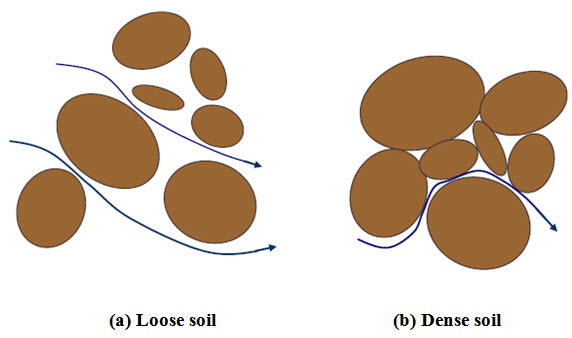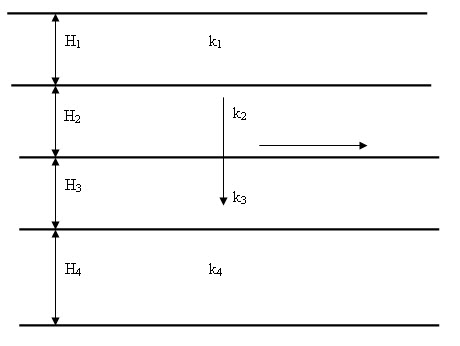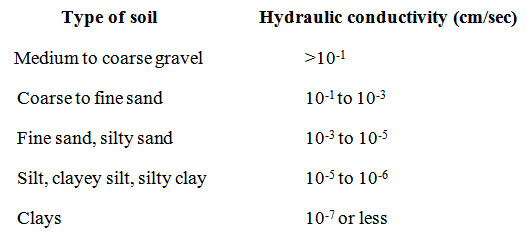Site pages
Current course
Participants
General
MODULE 1. Fundamentals of Soil Mechanics
MODULE 2. Stress and Strength
MODULE 3. Compaction, Seepage and Consolidation of...
MODULE 4. Earth pressure, Slope Stability and Soil...
Keywords
29 March - 4 April
5 April - 11 April
12 April - 18 April
19 April - 25 April
26 April - 2 May
LESSON 17. Permeability of Soil
17.1 Introduction
Permeability of the soil quantitatively describes how easily water can flow through it. In loose soil, amount of pores within the soil grains is more. Water can flow easily through loose soils. However, in case of dense soil, amount of pores within the soil grains is less. Water can not flow easily through dense soils (as shown in Figure 17.1). Thus, permeability is high in case of loose soil whereas, it is low in case of dense soil.

Fig.17.1. Flow of water a different type of soils
Darcy’s Law
Velocity (v) of flow is proportional to the hydraulic gradient (i). Thus,
V = Ki (17.1)
where k is the coefficient of permeability (cm/sec) or hydraulic conductivity. If i is equal to one, the v = k. Thus, coefficient of permeability is velocity of water for unit hydraulic gradient. Hydraulic gradient can be expressed as: i = Δh / L , where Δh is the head loss and L is the length between two points (as shown in Figure 17.2).

Fig.17.2. Flow of water
17.2. Permeability in layered soil
Figure 17.3 shows a layered soil system. The thickness of each layer is H1, H2, H3 ………. Hn. The coefficient of permeability is k1, k2, k3 …………… kn. In case of horizontal flow, it takes place through all the layers at the same time. Thus, hydraulic gradient is same for all the layers, i.e i1 = i2= i3= …… in = i, where n is the number of layers. However, the velocity of flow is different in different layer.

Fig. 17.3. Permeability of layered soil
According to Darcy’s law, the average discharge velocity (vavg) can be written as:
\[{v_{avg}}={k_H}i={1 \over H}({v_1}{H_1} + {v_2}{H_2} + ............. + {v_n}{H_n})\] (17.2)
where kH is the coefficient of horizontal permeability, v1, v2 …….vn is the velocity of flow in different layers. H is the total thickness of the layers, i.e H1+H2+………+Hn = H. The Eq. (17.2) can be written as:
\[{k_H}i={1 \over H}({k_1}i{H_1} + {k_2}i{H_2} + ............. + {k_n}i{H_n})\] (17.3)
\[{k_H}={1 \over H}({k_1}{H_1} + {k_2}{H_2} + ............. + {k_n}{H_n})\] (17.4)
In case of vertical flow, the hydraulic gradient is different in each layer. However, the velocity of flow is same in all the layers. The total head loss is h and the head losses in each layer is h1, h2, ………hn.
Head loss in each layer, \[{h_1}={H_1}{i_1}\] , \[{h_2}={H_2}{i_2}\].......................\[{h_n}={H_n}{i_n}\] (17.5)
Thus, the total head loss \[h={H_1}{i_1} + {H_2}{i_2} + .................. + {H_n}{i_n}\] (17.6)
The velocity of flow is same in all the layers. Thus,
\[v={k_v}{h \over H}={k_1}{i_1}\] (17.7)
where kv is the coefficient of vertical permeability.
Thus,
\[{k_v}={{H{k_1}{i_1}} \over {{H_1}{i_1} + {H_2}{i_2} + ..........{H_n}{i_n}}}\] (17.8)
\[{k_v} = \frac{{H{k_1}{i_1}}}{{\frac{{{H_1}}}{{{k_1}}} + \frac{{{H_2}}}{{{k_2}}} + .......... + \frac{{{H_n}}}{{{k_n}}}}}\] (17.9)
For more information see the Appendix 17.1
17.3. Factors affecting permeability
Some of the factors affecting permeability are:
Grain Size
Viscosity and temperature
Void ratio
Soil fabric of clay
Typical values of coefficient of permeability of various soils are presented as (Das, 1999):

Appendix 17.1
Head loss in each layer, \[{h_1}={H_1}{i_1}\] , \[{h_2}={H_2}{i_2}\]...................\[{h_n}={H_n}{i_n}\] (17.10)
The total head loss \[h={h_1} + {h_2} + .................. + {h_n}\] (17.11)
The velocity of flow is same in all the layers. Thus,
\[v={k_v}{h \over H}={k_1}{{{h_1}} \over {{H_1}}}={k_2}{{{h_2}} \over {{H_2}}}=\cdots={k_i}{{{h_i}}\over {{H_i}}}=\cdots={k_n}{{{h_n}} \over {{H_n}}}\] (17.12)
where kv is the coefficient of vertical permeability. Rearranging,
\[h=v{H \over {{k_v}}}\quad {h_1}=v{{{H_1}}\over{{k_1}}}\quad {h_2}=v{{{H_2}}\over{{k_2}}}\quad\cdots{h_i}=v{{{H_i}}\over{{k_i}}}\quad\cdots{h_n}=v{{{H_n}}\over{{k_n}}}\] (17.13)
The total head loss
\[h=v{H \over{{k_v}}}=v{{{H_1}}\over {{k_1}}}+v{{{H_2}}\over{{k_2}}}+\cdots v{{{H_i}}\over{{k_i}}}+\quad\cdots v{{{H_n}}\over {{k_n}}}\] (17.14)
\[{H \over{{k_v}}}={{{H_1}}\over{{k_1}}}+{{{H_2}}\over {{k_2}}}+\cdots{{{H_i}} \over {{k_i}}}+\quad\cdots{{{H_n}}\over {{k_n}}}\] (17.15)
\[{k_v} = \frac{H}{{\frac{{{H_1}}}{{{k_1}}}+\frac{{{H_2}}}{{{k_2}}}+\cdots\frac{{{H_i}}}{{{k_i}}}+\quad\cdots\frac{{{H_n}}}{{{k_n}}}}}\] (17.16)
References
Ranjan, G. and Rao, A.S.R. (2000). Basic and Applied Soil Mechanics. New Age International Publisher, New Delhi, India.
PPT of Professor N. Sivakugan, JCU, Australia.
Suggested Readings
-
Ranjan, G. and Rao A.S.R. (2000) Basic and Applied Soil Mechanics. New Age International Publisher, New Delhi, India.
-
Arora, K.R. (2003) Soil Mechanics and Foundation Engineering. Standard Publishers Distributors, New Delhi, India.
-
Murthy V.N.S (1996) A Text Book of Soil Mechanics and Foundation Engineering, UBS Publishers’ Distributors Ltd. New Delhi, India.
-
PPT of Professor N. Sivakugan, JCU, Australia (www.geoengineer.org/files/permy-Sivakugan.pps).
-
Das, B.M. (1999). Principles of Foundation Engineering. PWS Publishing, USA.